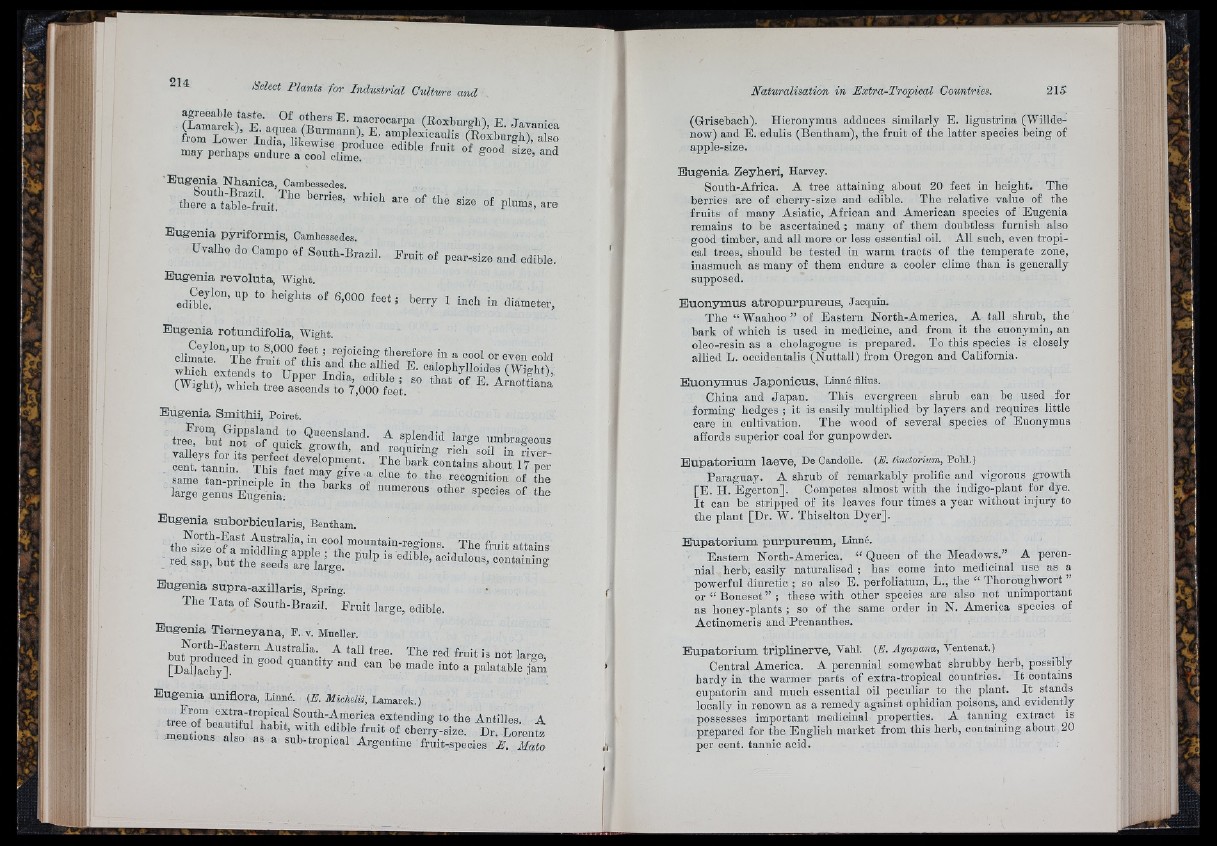
|t:
E u g e n ia N h a n io a , Cambessedes
therratblTfruit.'"'''' are
E u g e n ia p y rifo rm is , Cambessedes.
Uvalbo do Campo of South-Brazil. F ru it of pear-size and edible.
E u g e n ia re v o lu ta , Wight.
e d i l i 1 ¡„eh in diameter,
E u g e n ia ro tu n d ifo lia Wight iliS lilp iS ! S
E u g e n ia Sm ith ii, Poiret.
t r e l , i „ t l ; r i i : k t r i l l i umbrageo„s
l i i i " ^ieiopmenr^iXnouTaLraiol Ì : ;
E u g e n ia su b o rb ic u la r is , Bentham.
E u g e n ia s u p r a -a x illa r is , Spring.
The Tata of South-Brazil. F ru it large, edible.
E u g e n ia T ie rn e y a n a , F. v. Mueller
E u g e n ia u n iflo ra , Linné. (H. MicUlii, Lamarck.)
From extra-tropical South-America extending to the Antilles A
bee of beautiful habit, with edible fruit of c h e r f y -L t c f Borente
mentions also as a sub-tropical Argentine fruit-species A. Mato
(Grisebach). Hieronymus adduces similarly E. ligustrina (Willdenow)
and E. edulis (Bentham), the fruit of the latter species being of
apple-size.
E u g e n ia Zey h e ri, Harvey.
South-Africa. A tree attaining about 20 feet in height. The
berries are of cherry-size and edible. The relative value of the
fruits of many Asiatic, African aud American species of Eugenia
remains to be ascertained ; many of them doubtless furnish also
good timber, and all more or less essential oil. All such, even tropical
trees, should be tested in warm tracts of the temperate zone,
inasmuch as many of them endure a cooler clime than is generally
supposed.
B u o n ym u s a tr o p u rp u r e u s , Jacquin.
The “ Waahoo” of Eastern North-America. A tall shrub, the
bark of which is nsed in medicine, and from it the euonymin, an
oleo-resin as a cholagogue is prepared. To this species is closely
allied L. occidentalis (Nuttall) from Oregon and California.
B u o n ym u s J a p o n ic u s , Linné filins.
China and Japan. This evergreen shrub can be used for
forming hedges ; it is easily multiplied by layers and requires little
care in cultivation. The wood of several species of Euonymus
affords superior coal for gunpowder.
B u p a to r i u m la e v e , He Candolle. (E. tinctorium, Pohl. )
Paraguay. A shrub of remarkably prolific and vigorous growth
[E . H. Egerton]. Competes almost with the indigo-plant for dye.
I t ean he stripped of its leaves four times a year without injury to
th e plant [Dr. W. Thiselton Dyer],
B u p a to r ium p u rp u r e um , Linné.
Eastern North-America. “ Queen of the Meadows.” A perennial
herb, easily naturalised ; has come into medicinal use as a
powerful diuretic ; so also E. perfoliatum, L., the “ Thoroughwort
or “ Boneset ” ; these with other species are also not unimportant
as honey-plants ; so of the same order in N. America species of
Actinomeris and Prenanthes.
E u p a to r ium tr ip lin e rv e , Vahl. (E. Ayapana, Ventenat.)
Central America. A perennial somewhat shrubby herb, possibly
hardy in the warmer parts of extra-tropical countries. I t contains
eupatorin and much essential oil peculiar to the plant. I t stands
locally in renown as a remedy against ophidian poisons, and evidently
possesses important medicinal properties. A tanning extract is
prepared for the English market from this herb, containing about 20
per cent, tannic acid.